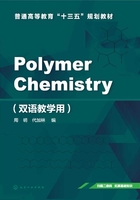
1.2 AVERAGE MOLECULAR WEIGHT AND DISTRIBUTION
A major distinguishing feature of polymers is their enormous(巨大的)molecular weight.Molecular weights of 2×104 are routine(常规),and values as high as 2×107 are not uncommon.However,unlike small molecules such as benzene(苯)or chloroform(氯仿),a sample of a synthetic polymers has no single,fixed molecular weight.Instead,there is a distribution of different molecular weights in the same sample of material(Figure 1.7).For this reason,it is necessary to talk about average molecular weights rather than a single defining value.

Figure 1.7 Molecular weight distributions
Several different types of average molecular weights are used in polymer chemistry,the most important of which are known as number average molecular weight  ,and weight average molecular weight
,and weight average molecular weight  and viscosity average molecular weight
and viscosity average molecular weight  .They are defined as shown in equation(1-1),equation(1-2)and equation(1-3),respectively.
.They are defined as shown in equation(1-1),equation(1-2)and equation(1-3),respectively.
Number average molecular weight:
 (1-1)
(1-1)
Weight average molecular weight:
 (1-2)
(1-2)
Viscosity average molecular weight:
 (1-3)
(1-3)
Where Ni is the number of molecules of molecular weight Mi,and Xi is the number fraction or mole fraction of molecules having molecular weight Mi,and where wi is the weight of molecular weight Mi,and Wi is the weight fraction of molecules with molecular weight Mi,and where a is the index(指数)of the relationship between the molecular weight and the inherent viscosity(特性黏数)of the dilute polymer solution,and generally its value is within the scope of 0.5-0.9.
 can be obtained from the study of the osmotic pressure(渗透压)of polymer solutions,whereas
can be obtained from the study of the osmotic pressure(渗透压)of polymer solutions,whereas  values are obtained from light scattering(光散射)or ultracentrifugation(超离心分离)experiments.The technique known as gel permeation chromatography(凝胶渗透色谱)or size exclusion chromatography(尺寸排阻色谱)gives both
values are obtained from light scattering(光散射)or ultracentrifugation(超离心分离)experiments.The technique known as gel permeation chromatography(凝胶渗透色谱)or size exclusion chromatography(尺寸排阻色谱)gives both  and
and  values.In general,
values.In general, values are higher than
values are higher than  ,because the calculations for
,because the calculations for  give more emphasis to the larger molecules,while
give more emphasis to the larger molecules,while  calculations give equal emphasis to all molecules.The viscosity average molecular weight
calculations give equal emphasis to all molecules.The viscosity average molecular weight  is determined using capillary viscometer(毛细管黏度计)by the viscosity method.
is determined using capillary viscometer(毛细管黏度计)by the viscosity method.
The fraction  /
/ (called the polydispersity,多分散性)is a measure of the molecular weight distribution.If the value of
(called the polydispersity,多分散性)is a measure of the molecular weight distribution.If the value of  /
/ is close to 1(1.01 or 1.02 for instance),the distribution is very narrow.Such polymer is called as monodisperse polymer or uniform polymer.If it is,say,2 or higher,the distribution is considered to be very broad.The molecular weight distribution affects several important polymer properties.For example,polymers with very broad distributions are less prone to crystallize than their narrow distribution counterparts,and they often have lower solidification temperatures.The polymer with shorter chains plasticize(塑化)the bulk material and make it softer.Thus,together with(与……一起)the glass transition temperature Tg(玻璃化转变温度)and the crystalline melting temperature(晶体熔融温度)Tm,
is close to 1(1.01 or 1.02 for instance),the distribution is very narrow.Such polymer is called as monodisperse polymer or uniform polymer.If it is,say,2 or higher,the distribution is considered to be very broad.The molecular weight distribution affects several important polymer properties.For example,polymers with very broad distributions are less prone to crystallize than their narrow distribution counterparts,and they often have lower solidification temperatures.The polymer with shorter chains plasticize(塑化)the bulk material and make it softer.Thus,together with(与……一起)the glass transition temperature Tg(玻璃化转变温度)and the crystalline melting temperature(晶体熔融温度)Tm, is a crucial characteristic of any synthetic polymers.
is a crucial characteristic of any synthetic polymers.
In turn,the size relationship of the three kinds of average molecular weight is  .
.
 (参见本章二维码:1-4 分子量及分子量分布计算举例)
(参见本章二维码:1-4 分子量及分子量分布计算举例)